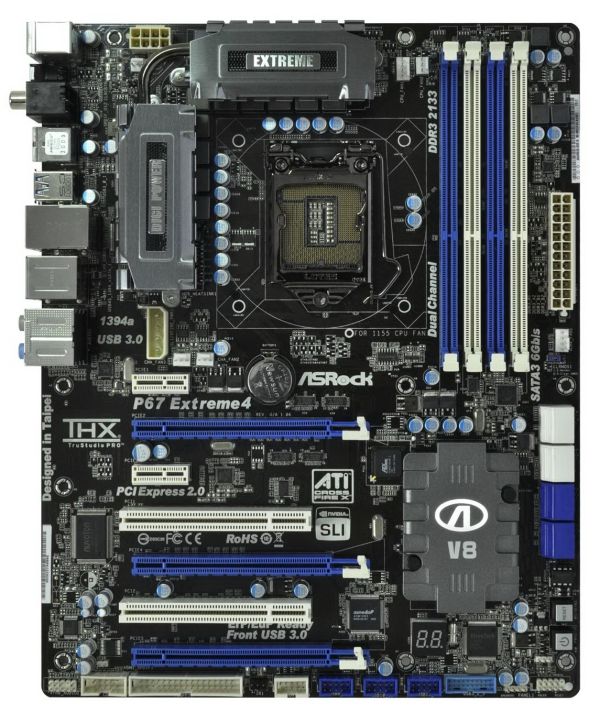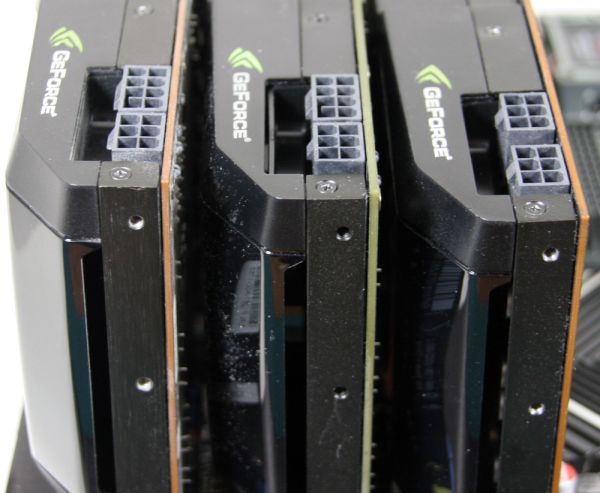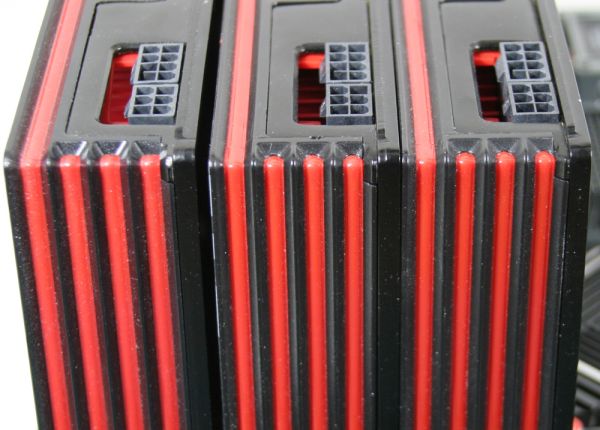A Look At Triple-GPU Performance And Multi-GPU Scaling, Part 1
by Ryan Smith on April 3, 2011 7:00 AM ESTFitting Three Video Cards in an ATX Case
I thought we’d flip our normal GPU review style on its head by starting with Power, Temperature, and Noise first. NVIDIA and AMD have both long recommended against placing high-end video cards directly next to each other, in favor of additional spacing between video cards. Indeed this is a requirement for their latest dual-GPU cards, as both the GTX 590 and 6990 draw relatively massive amounts of air using a fan mounted at the center of the card and exhaust roughly half their air inside of the case. Their reference style single-GPU cards on the other hand are fully exhausting with fans mounted towards the rear of the card. Thus multi-GPU configurations with the cards next to each other is supposed to be possible, though not ideal.
There’s a reason I want to bring this up first, and a picture is worth a thousand words.
While AMD and NVIDIA’s designs share a lot in common – a rear-mounted blower fan pushes air over a vapor chamber cooler – the shrouds and other external equipment are quite different. It’s not until we see a picture that we can appreciate just how different they are.
With the Radeon HD 6000 series, AMD’s reference designs took on a very boxy design. The cards fully live up to the idea of a “black box”; they’re enclosed on all sides with a boxy cooler and a black metal backplate. As a GPU reviewer I happen to like this design as the GPUs are easy to stack/store, and the backplate covers what would normally be the only exposed electronics on the card. The issue with this boxy design is that AMD is taking full advantage of the PCIe specification, leading to the 6900 series being the full width allowed.
NVIDIA on the other hand has always had some kind of curve in their design, normally resulting in a slightly recessed shroud around the blower intake. For the GTX 580 and GTX 570 they took a further step in recessing the shroud around this area, leading to the distinct wedge shape. At the same time NVIDIA does not use a backplate, saving precious millimeters of space. The end result of this is that even when packed like sardines, the GTX 580 and GTX 570 blowers have some space reserved for air intake.
The Radeon HD 6970 does not, and this is our problem. The picture of the 6970 in triple-CF really paints the picture, as the middle card is directly pressed up against the top card. Because these cards are so large and heavy the rear ends tend to shift and dip some when installed against a vertical motherboard – in fact this is why we can normally get away with a dense dual-CF setup since the bottom card dips a bit more – but in a triple-CF configuration the end result is that one of the cards will end up getting up-close and personal with another one.
Without outside intervention this isn’t usable. We hit 99C on the middle card in Crysis when we initially installed the three cards, and Crysis isn’t the hardest thing we run. For the purposes of our test we ultimately resorted to wedging some space between the cards with wads of paper, but this isn’t a viable long-term solution.
Unfortunately long-term alternatives are few if you want to give a triple-GPU setup more space. Our testbed uses an Asus Rampage II Extreme, which features three PCIe slots mixed among a total of 6 slots; the way it’s laid out makes it impossible to have our triple-GPU configuration setup in any other manner. Even something like the ASRock P67 Extreme4 can’t escape the fact that the ATX spec only has room for 7 slots and that when manufacturers actually use the 7th and topmost slot that it’s a short PCIe x1 slot. In short you won’t find an ATX motherboard that can fit three video cards and at the same time gives each one a slot’s worth of breathing room. For that you have to use a larger than ATX form factor.

So what’s the point of all of this rambling? With AMD’s current shroud design it’s just not practical to do triple-CF on air on an ATX motherboard. If you want to play with three AMD boards you need to think outside of the box: either use water cooling or use a larger motherboard.












97 Comments
View All Comments
Sabresiberian - Tuesday, April 5, 2011 - link
I've been thinking for quite awhile that we need something different, and this is the primary reason why - I can't get all I want to install on any ATX mainboard I know of.;)
Sabresiberian - Tuesday, April 5, 2011 - link
I've always thought minimum frame rate is where the focus should be in graphics card tests (when looking at the frame rate performance aspect), instead of the average. It's the minimum frame rate that bothers people or even makes a game unplayable.Thanks!
;)
mapesdhs - Wednesday, April 6, 2011 - link
I hate to say it but with the CPU at only 3.33, the results don't really mean that much. I know
the 920 used can't go higher, but it just seems a bit pointless to do all these tests when the
results can't really be used as the basis for making a purchasing decision because of a very
probably CPU bottleneck. Surely it would have been sensible for an article like this to replace
the 920 with a 950 and redo the oc to 4+. The 950 is good value now aswell. Or even the
entry 6-core.
Re slot spacing, perhaps if one insists on using P67 it can be hard to sort that out, but there
*are* X58 boards which provide what one needs, eg. the Asrock X58 Extreme6 does have
double-slot spacing between each PCIe slot, so 3 dual-slot cards would have a fully empty
slot between each card for better cooling. Do other vendors make a board like this? I couldn't
find one after a quick check on the Gigabyte or ASUS sites. Only down side is with all 3 slots
used the Extreme6 operates slots 2 and 3 at 8x/8x; for many games this isn't an issue (depends
on the game), but I'm sure some would moan nonetheless.
Would be interesting to know how that would compare though, ie. a 4GHz 950 on an Extreme6
for these tests.
Unless I missed it somehow, I'm a tad surprised Gigabyte don't make an X58 board with this type
of slot spacing, or do they?
Ian.
xAlex79 - Thursday, April 14, 2011 - link
I am a bit disapointed Ryan in the way you put your conclusions.At the start of the article you highlight how you are going to look at Trifire and Tri-Sli and compare how it does for the value.
Yet at the end in your conclusion there isnt a single mention or even adjusted scores considering value at all. And that makes Nvidia look alot better than they should. It is as you completely forget that three 580s costs you 1500$ and that three 6970s costs you 900$.
Based on that and the fact YOU stated you would take value into account (And personally I think posting any kind of review without value nowdays is just irresponsible and biased) I am very disapointed with an otherwise very good set of tests.
I also understand that this is labeled "Part 1" and that the value might come into "Part 2" but you should have CLEARLY outlined that in your conclusion were that the case. And given the quality of reviews that we have come to expect from Anantech, the final numbers should ALWAYS include a value perspective.
I will jsut outline that it is poor form and not very professional and that in the end the people you should care about are us, your readers. Not how you look or try to look for hardware manifacturers. If this was a mistake, you should correct it asap. It does not make you look good.
L1qu1d - Friday, April 15, 2011 - link
I wonder why they didn't opt for the 270.51 Drivers and went with 3 month old drivers?Compared to the tested drivers:
GeForce GTX 580:
Up to 516% in Dragon Age 2 (SLI 2560x1600 8xAA/16xAF Very High, SSAO on)
Up to 326% in Dragon Age 2 (1920x1200 8xAA/16xAF Very High, SSAO on)
Up to 11% in Just Cause 2 (1920x1200 8xAA/16xAF, Concrete Jungle)
Up to 11% in Just Cause 2 (SLI 2560x1600 8xAA/16xAF, Concrete Jungle)
Up to 7% in Civilization V (1920x1200 4xAA/16xAF, Max settings)
Up to 6% in Far Cry 2 (SLI 2560x1600 8xAA/16xAF, Max settings)
Up to 5% in Civilization V (SLI 1920x1200 8xAA/16xAF, Max settings)
Up to 5% in Left 4 Dead 2 (1920x1200 noAA/AF, Outdoor)
Up to 5% in Left 4 Dead 2 (SLI 2560x1600 4xAA/16xAF, Outdoor)
Up to 4% in H.A.W.X. 2 (SLI 1920x1200 8xAA/16xAF, Max settings)
Up to 4% in Mafia 2 (SLI 2560x1600 AA on/16xAF, PhysX = High)
Fony - Thursday, April 28, 2011 - link
taking forever for the Eyefinity/Surround testing.vipergod2000 - Thursday, May 5, 2011 - link
The one thing that erks me is that the i7-920 OCed to ~3.3Ghz - causing the scaling of 3 cards being greatly reduced as opposed to other forum users that have 3 or 4 cards in CFX or SLI but with fantastic scaling - but assured with a coupling a i7-2600k at 5ghz minimum or a 980x/990x at 4.6ghz+